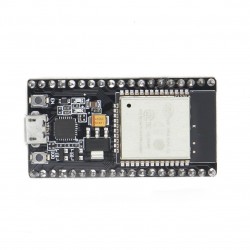The NodeMCU, Wemos D1, ESP8266, CP2102, and CH340 are all related to the ESP8266-based development boards. Let's take a look at each of them:
1. NodeMCU: The NodeMCU is an open-source IoT platform that utilizes the ESP8266 Wi-Fi module. It provides an easy-to-use firmware and development environment, making it popular for Internet of Things (IoT) projects. The NodeMCU board usually includes a built-in USB-to-serial converter (such as the CP2102 or CH340) for programming and power supply.
2. Wemos D1: The Wemos D1 is another development board based on the ESP8266 module. It is compatible with Arduino and offers similar functionality to the NodeMCU board. The Wemos D1 boards often come with built-in USB-to-serial converters like the CP2102 or CH340.
3. ESP8266: The ESP8266 is a low-cost Wi-Fi module that gained popularity for its ability to connect microcontrollers to Wi-Fi networks. It integrates a microcontroller and Wi-Fi functionality, allowing it to be programmed and used as a standalone module or in conjunction with other microcontrollers like Arduino. The ESP8266 module itself does not have built-in USB connectivity.
4. CP2102: The CP2102 is a popular USB-to-serial converter chip that provides a bridge between USB and UART (serial) interfaces. It is often used in conjunction with ESP8266-based boards, including the NodeMCU and Wemos D1, to enable USB connectivity for programming and communication with the board.
5. CH340: Similar to the CP2102, the CH340 is another USB-to-serial converter chip commonly used in ESP8266-based development boards. It also provides a means for USB connectivity, enabling programming and communication with the board.
Both the CP2102 and CH340 are used to convert the USB signals from a computer into UART signals that the ESP8266 module can understand.
These boards and components are often chosen based on personal preference, availability, and specific project requirements. They are widely used for IoT applications, home automation, prototyping, and other projects that require Wi-Fi connectivity and microcontroller functionality.
-
Your shopping cart is empty!
-
Mixed Menu
New
Top Sellers
Heat transfer law making circuit boards, circuit board is drawn graphics, laser printers print in thermal transfer paper, and then covered in Bo..₹12.0When drilling holes in a printed circuit board (PCB) for electronic components, specific drill bits called PCB drill bits or PCB drills are used. Thes..₹10.2When drilling holes in a printed circuit board (PCB) for electronic components, specific drill bits called PCB drill bits or PCB drills are used. Thes..₹10.2A 240V round 2-pin female electrical plug connector for an extended power cord typically refers to a specific type of plug used for connecting applian..₹15.0 - Blog
NodeMCU/ESP
The NodeMCU, Wemos D1, ESP8266, CP2102, and CH340 are all related to the ESP8266-based development boards. Let's take a look at each of them:
1. NodeMCU: The NodeMCU is an open-source IoT platform that utilizes the ESP8266 Wi-Fi module. It provides an easy-to-use firmware and development environment, making it popular for Internet of Things (IoT) projects. The NodeMCU board usually includes a built-in USB-to-serial converter (such as the CP2102 or CH340) for programming and power supply.
2. Wemos D1: The Wemos D1 is another development board based on the ESP8266 module. It is compatible with Arduino and offers similar functionality to the NodeMCU board. The Wemos D1 boards often come with built-in USB-to-serial converters like the CP2102 or CH340.
3. ESP8266: The ESP8266 is a low-cost Wi-Fi module that gained popularity for its ability to connect microcontrollers to Wi-Fi networks. It integrates a microcontroller and Wi-Fi functionality, allowing it to be programmed and used as a standalone module or in conjunction with other microcontrollers like Arduino. The ESP8266 module itself does not have built-in USB connectivity.
4. CP2102: The CP2102 is a popular USB-to-serial converter chip that provides a bridge between USB and UART (serial) interfaces. It is often used in conjunction with ESP8266-based boards, including the NodeMCU and Wemos D1, to enable USB connectivity for programming and communication with the board.
5. CH340: Similar to the CP2102, the CH340 is another USB-to-serial converter chip commonly used in ESP8266-based development boards. It also provides a means for USB connectivity, enabling programming and communication with the board.
Both the CP2102 and CH340 are used to convert the USB signals from a computer into UART signals that the ESP8266 module can understand.
These boards and components are often chosen based on personal preference, availability, and specific project requirements. They are widely used for IoT applications, home automation, prototyping, and other projects that require Wi-Fi connectivity and microcontroller functionality.













































